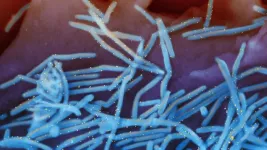(Press-News.org)
Monitoring the changes caused in the brain at the molecular level by cancer and other neurological pathologies in a non-invasive way is one of the great challenges of biomedical research. A new technique, still in the experimental stage, achieves this by introducing light into the brains of mice using a very thin probe. The innovation, which is published today in the journal Nature Methods, is ledby an international team including groups from the Spanish National Research Council (CSIC) and the Spanish National Cancer Research Centre (CNIO).
The authors refer to the new technique as a ‘molecular lantern’, as it provides information on the chemical composition of brain tissue in response to light. This allows analysis of molecular changes caused by tumours, whether primary or metastatic, and also by injuries such as head trauma.
The molecular lantern is a probe of less than 1 mm thick, with a tip just a thousandth of a millimetre (a micron), invisible to the naked eye. It can be inserted deep into the brain without causing damage (as an example, a human hair measures between 30 and 50 microns in diameter).
The probe is not yet ready for use in patients; for now it is primarily a ‘promising’ research tool in animal models that allows ‘monitoring molecular alterations caused by traumatic brain injury, as well as detecting diagnostic markers of brain metastasis with high accuracy,’ explain the authors of the paper.
The work has been carried out by the European consortium NanoBright, in which two Spanish groups participate, the one led by Liset Menéndez de la Prida at the Neuronal Circuits Laboratory of the Cajal Institute of the CSIC, and the Brain Metastasis Group of the CNIO directed by Manuel Valiente. Both have been involved in the biomedical research on NanoBright, while groups from Italian Institute of Technology and French institutions such as the Laboratoire Kastler Brossel, have developed the instrumentation.
Scanning the brain with light without altering it previously
Activating or recording brain function using light is not new. For example, the so-called optogenetic technique make it possible to monitor the activity of individual neurons with light. However, this requires introducing a gene into the neurons that makes them sensitive to light. With the new technology now presented by NanoBright, it is possible to study the brain without altering it beforehand, which represents a paradigm shift in biomedical research.
The new molecular lantern is based on a technique called vibrational spectroscopy, which leverages the Raman effect—a unique property of light. “When light interacts with molecules, it scatters in a way that depends on their composition and chemical structure. This scattering produces a distinct signal, or spectrum, that acts as a molecular fingerprint, providing detailed information about the composition of the illuminated tissue”, explain Liset M. de la Prida from CSIC.
“We can see any molecular change produced in the brain by a pathology or injury”
“This technology allows us to study the brain in its natural state; it is not necessary to alter it beforehand. But it also makes it possible to analyse any type of brain structure, not only those that have been genetically marked or altered, as was the case with the technologies used until now. With vibrational spectroscopy we can see any molecular change in the brain when there is a pathology”, explains Manuel Valiente, from the CNIO.
Raman spectroscopy is already used in neurosurgery, although in an invasive and less precise way: “There have been studies of its use when operating on brain tumours in patients,’ says Valiente. In the operating room, once the bulk of the tumour has been surgically removed, it is possible to introduce a Raman spectroscopy probe to assess whether cancer cells remain in the area. That is, it is only used when the brain is already open and the hole is large enough. But these relatively large ‘molecular lanterns’ are incompatible with minimally invasive use in live animal models”.
For the CNIO group, one goal now is to find out whether the information provided by the probe allows “differentiating different oncological entities, for example, the types of metastases according to their mutational profiles, by their primary origin or from different types of brain tumours”.
Artificial intelligence to search for diagnostic markers
The Cajal Institute group has used the technique to investigate the epileptogenic zones surrounding traumativc brain injuries. “We were able to identify different vibrational profiles in the same brain regions susceptible to epileptic seizures, depending on their association with a tumour or trauma. This suggests that the molecular shadows of these areas are affected differently, and can be used to separate different pathological entities by automatic classification algorithms including artificial intelligence”, explains Liset M. de la Prida.
“The integration of vibrational spectroscopy with other modalities for recording brain activity and advanced computational analysis with artificial intelligence will allow us to identify new high-precision diagnostic markers, which will facilitate the development of advanced neurotechnologies for new biomedical applications”, summarizes the CSIC researcher, Liset M. de la Prida
END
MONTREAL, Quebec, Canada, 31 December 2024 - In a comprehensive Genomic Press Interview, renowned neuroscientist Dr. Michael Meaney reveals pivotal discoveries about the intricate relationship between genes and environment in shaping brain health. As a James McGill Professor Emeritus and former Director of the Translational Neuroscience program at ASTAR Singapore, Dr. Meaney's research has fundamentally altered our understanding of how early-life experiences influence genetic expression and brain development.
"I have always been genuinely fascinated ...
JERUSALEM, Israel, 31 December 2024 - In a comprehensive Genomic Press Interview, distinguished neuroscientist Professor Raz Yirmiya unveils transformative insights into the relationship between inflammation and depression. As head of the Laboratory for Psychoneuroimmunology at the Hebrew University of Jerusalem, Professor Yirmiya's work has fundamentally changed our understanding of depression's biological underpinnings.
"Most depressed patients do not have any overt inflammatory disease. However, we and others found that exposure to stress, which is the most significant trigger of depression in humans and animals, also ...
ATLANTA, Georgia, USA, 31 December 2024 - In a comprehensive Genomic Press Interview, Emory University MD candidate Fayzan Rab shares insights into his pioneering research on the economic and public health implications of psychedelic therapy implementation. Rab's work at the Emory Center for Psychedelics and Spirituality bridges the gap between clinical research and real-world healthcare delivery systems.
"It would be a fool's errand to say that psychedelic therapies alone would change that," says Rab, discussing mental healthcare challenges. "Treating mental illness will require changes within clinical practice but also investments into social safety ...
A Medical University of South Carolina Hollings Cancer Center researcher is exploring new ways to improve treatment options for kidney cancer patients. With funding from a Department of Defense (DOD) Academy of Kidney Cancer Investigators Early Career Scholar Award, Aguirre de Cubas, Ph.D., will investigate how the immune system can be boosted to detect and kill kidney tumors. Congress established the award in 2017 to support research with high potential impact and exceptional scientific merit. De Cubas’ approach focuses on reactivating the immune system to recognize and target cancer cells better, offering new possibilities for improving existing ...
Embargoed for release until 5:00 p.m. ET on Monday 30 December 2024
@Annalsofim
Below please find summaries of new articles that will be published in the next issue of Annals of Internal Medicine. The summaries are not intended to substitute for the full articles as a source of information. This information is under strict embargo and by taking it into possession, media representatives are committing to the terms of the embargo not only on their own behalf, ...
(Calgary) — A study from a Mount Royal University physiologist and his team demonstrates the key role of the kidneys in acclimatization to high altitude, and illustrates another way that Sherpas are better adapted to high altitude ascent.
Results from the study were recently published in in the prestigious international science journal Proceedings of the National Academy of Sciences.
The paper, “Comparing integrative ventilatory and renal acid-base acclimatization in lowlanders and Tibetan highlanders during ascent to 4,300 m”, describes findings ...
SAN ANTONIO, Dec. 30, 2024 – Patients with opioid use disorder can reduce their days of opioid use and stay in treatment longer when using a smartphone app as supportive therapy in combination with medication, a new study by The University of Texas Health Science Center at San Antonio (UT Health San Antonio) shows.
The cohort study of 600 underserved patients found that those who chose to use the app – which combines contingency management behavioral therapy and recovery support from peers – and alongside medication, reduced their days of opioid use by 35% compared with ...
Key Takeaways
A new study finds little evidence that hospital mergers and acquisitions reduce costs or improve quality of care.
More strategic quality improvement efforts are needed for patients to benefit from health care integration.
CHICAGO (December 30, 2024) — Mergers and acquisitions of U.S. hospitals and health systems rarely improve the quality of care delivered or result in lower health care costs and prices, according to a study published in the Journal of the American College of Surgeons (JACS).
The study, a systematic review of hundreds of published ...
FOR IMMEDIATE RELEASE
Johns Hopkins Medicine researchers have shown that people 60 years or older with weakened immunity — primarily organ transplant recipients who take immunosuppressive medications to reduce the risk of rejection and others with immune system disorders — do not respond as strongly to vaccines against the respiratory syncytial virus (RSV) as people in the same age group with normal immune function.
The study, conducted by a research team at the Johns Hopkins Transplant Research Center, was published today in the Journal of the American ...
In a new analysis of data from more than a dozen studies, coffee and tea consumption was linked with lower risks of developing head and neck cancers, including cancers of the mouth and throat.
Cancers of the head and neck are the seventh most common forms of cancer worldwide, and rates are rising in low- and middle-income countries. Many studies have assessed whether drinking coffee or tea is associated with head and neck cancer, with inconsistent results.
To provide additional insight, investigators led by the University of Utah’s Huntsman Cancer Institute examined data from ...




